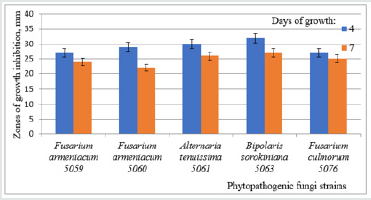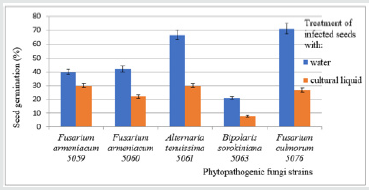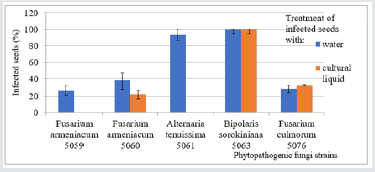
Lupine Publishers Group
Lupine Publishers
Menu
ISSN: 2641-6794
Mini Review(ISSN: 2641-6794) 
Activity of the Strain Streptomyces hydrogenans against Phytopathogenic Fungi Volume 1 - Issue 5
Mariya V Demiankova1,2, Elena A Kalashnikova2, Alla A Glukhova1, Tatiana D Ivankova1, Larisa P Terekhova1, Yuliya V Boykova1, Tatiana A Efimenko1 and Olga V Efremenkova1*
- 1Gause Institute of New Antibiotics, Moscow, Russia
- 2Moscow Timiryazev Agricultural Academy, Moscow, Russia
Received: December 01, 2018; Published: December 06, 2018
Corresponding author: Olga V Efremenkova, Gause Institute of New Antibiotics, Moscow, Russia
DOI: 10.32474/OAJESS.2018.01.000121
Abstract
Actinobacterium was isolated from the nature and shown that it has actymotic activity against five phytopathogenic fungi that infect cereals. The strain is identified as Streptomyces hydrogenans. It can be the basis for the development of plant protection products against phytopathogenic fungi.
Keywords: Environmental Pollution; Streptomyces hydrogenans; Phytopathogenic Fungi; Natural Antimycotics
Introduction
Chemical plant protection products cause dangerous environmental pollution [1,2]. After getting into drinking water sources and into agricultural products, they become a danger to people and animals [3,4]. It is difficult now to completely abandon chemical agents of plant protection, since a significant part of the crop may be lost due pests, diseases and weeds. Nevertheless, other modern plant protection means are known, which include agrotechnical methods, selection of resistant plant kinds, the use of biological agents [5]. These biological agents include actinobacteria - the natural components of soil biocenoses, which are characterized by the formation of a large number of various antimicrobial substances, including antimycotics. It is known that phytopathogenic fungi cause great harm to agricultural plants, and the fight against them is of great practical importance. The goal of our study was to search for actinobacteria, the natural inhabitants of the soil, which are active against phytopathogenic fungi that cause cereal diseases. Natural antimycotics, in contrast to artificially synthesized chemical remedies, have a selectivity of action and most of them, inhibiting the growth of phytopathogenic fungi, harmless to most other microorganisms, plants and animals.
Under the subproject ‘Strategies for Sustainable Management of Degraded Coastal land and Water for Enhancing Livelihood Security of the Farming Communities’ an intervention named ‘Land Shaping’ for improving rainwater harvesting and drainage for enhancing productivity at low lying degraded land including Tsunami affected land at the District South 24 Parganas in the state of West Bengal’ was extended to farmer’s field termed as Intervention (treated). The main objectives of Intervention were
As test objects, five strains of phytopathogenic fungi isolated from cereals in the Moscow region were used. Species identification was performed according to morphological features and the sequence of the ribosomal RNA gene. DNA amplification of the ribosomal genes was performed using a set of PCR Master Mix reagents (Thermo Scientific, USA) with fungal primers ITS1f (ctt ggt cat tta gag gaa gta a) and NL-4 (ggt ccg tgt ttc aag g) as well as bacterial primers 27f (aga gtt tga tcc tgg ctcag) and 1492r (tac ggy tac ctt gtt acg act t). PCR was performed on a Thermal Cycler 2720 device (Applied Biosystems, USA) according to the program: (1) 94°C for 1 minute, (2) 30 cycles with alternating temperature intervals of 94°C for 1 minute, 51°C for 1 minute, 72°C for 2 minutes, (3) 72°C for 7 minutes. The species affiliation of phytopathogenic strains was established on the basis of a 100% coincidence with type strains in the GenBank database: Fusarium armeniacum 5059, Fusarium armeniacum 5060, Alternaria tenuissima 5061, Bipolaris sorokiniana 5063 and Fusarium culmorum 5076. When searching for producers of antimycotics, an actinobacterial strain INA 01212, identified on the basis of morphological characters as Streptomyces hydrogenans, was sown from a potato tuber. Species affiliation was confirmed by the structure of the 16S rRNA gene. The sequence of the S. hydrogenans INA 01212 is deposited in GenBank (MK238399). S. hydrogenans INA 01212 was incubated under submerged conditions with aeration on rotary shaker with a rotation speed of 220 rpm at a temperature 28°C. Optimal was the nutrient medium No. 330 of the following composition (%): sucrose - 2.1, starch - 0.85, pea flour - 1.5, NaCl - 0.5, NaNO3 - 0.5, chalk - 0.5, tap water, pH 7.0. The highest level of antimycotic activity manifestation is achieved on the 4th day of cultivation. The activity of the culture fluid was established for all five phytopathogenic strains (Figure 1).
Figure 1: Antibiotic activity of the S. hydrogenans INA 01212 cultural liquid determined by the method of diffusion into agar against phytopathogenic fungi (diameters of growth inhibition zones are indicated in mm).

Figure 2: The percentage of wheat germinated seeds when grown using water (control) and cultural liquid S. hydrogenans INA 01212.

Figure 3: The percentage of infected wheat seeds when grown using water (control) and cultural liquid S. hydrogenans INA 01212.

To simulate the possible interaction of actinobacteria and phytopathogens in nature the activity of the S. hydrogenans INA 01212 culture fluid against phytopathogenic fungi on infected wheat seeds placed on filter paper in Petri dishes under sterile conditions was examined. Before infection with fungal spores, the seeds were sterilized with a solution of mercuric chloride. The culture liquid of S. hydrogenans INA 01212 was added to Petri dishes with infected seeds; water (5 ml each) was added to the control dishes. It is established that in these conditions, the culture fluid reduces seed germination somewhat (Figure 2), however, seed infection by the phytopathogens F. armeniacum 5059 and A. tenuissima 5061 was completely absent. The strain B. sorokiniana 5063 under these experimental conditions infected almost all the seeds, possibly due to the components of the nutrient medium that contributed to the growth of this phytopathogen (Figure 3).
Conclusion
Actinobacterium Streptomyces hydrogenans INA 01212 exhibits antimycotic activity in vitro against phytopathogenic fungi Fusarium armeniacum 5059, F. armeniacum 5060, F. culmorum 5076, Alternaria tenuissima 5061 and Bipolaris sorokiniana 5063. After seed treatment, the culture fluid somewhat suppressed seeds germination in vitro but completely prevents their infection with phytopathogens F. armeniacum 5059 and A. tenuissima 5061; B. sorokiniana 5063 infects 100% of wheat seeds, presumably due to nutrient components in cultural liquid that enhance the growth of this fungus in the experiment.
Bipolaris sorokinianaReferences
- M Scheringer, S Strempel, S Hukari, C A Ng, M Blepp, et al. (2012) How many Persistent Organic Pollutants should we expect? Atmospheric Pollution Research 3(4): 383-391.
- R Weber, M Schlumpf, T Nakano, J Vijgen (2015) The need for better management and control of POPs stockpiles. Environmental Science and Pollution Research 22(19): 14385-14390
- R Weber, G Aliyeva, J Vijgen (2013) The need for an integrated approach to the global challenge of POPs management. Environmental Science and Pollution Research 20(4): 1901-1906.
- C Alister, M Kogan (2005) ERI. Environmental risk index. A simple proposal to select agrochemicals for agricultural use. Crop Protection 25(3): 202-211.
- H Labite, F Butler and E Cummins (2009) A Review and Evaluation of Plant Protection Product Ranking Tools Used in Agriculture. Human and Ecological Risk Assessment: An International Journal 17(2): 300-327.

Top Editors
-

Mark E Smith
Bio chemistry
University of Texas Medical Branch, USA -

Lawrence A Presley
Department of Criminal Justice
Liberty University, USA -

Thomas W Miller
Department of Psychiatry
University of Kentucky, USA -

Gjumrakch Aliev
Department of Medicine
Gally International Biomedical Research & Consulting LLC, USA -

Christopher Bryant
Department of Urbanisation and Agricultural
Montreal university, USA -

Robert William Frare
Oral & Maxillofacial Pathology
New York University, USA -

Rudolph Modesto Navari
Gastroenterology and Hepatology
University of Alabama, UK -

Andrew Hague
Department of Medicine
Universities of Bradford, UK -

George Gregory Buttigieg
Maltese College of Obstetrics and Gynaecology, Europe -

Chen-Hsiung Yeh
Oncology
Circulogene Theranostics, England -
.png)
Emilio Bucio-Carrillo
Radiation Chemistry
National University of Mexico, USA -
.jpg)
Casey J Grenier
Analytical Chemistry
Wentworth Institute of Technology, USA -
Hany Atalah
Minimally Invasive Surgery
Mercer University school of Medicine, USA -

Abu-Hussein Muhamad
Pediatric Dentistry
University of Athens , Greece

The annual scholar awards from Lupine Publishers honor a selected number Read More...














